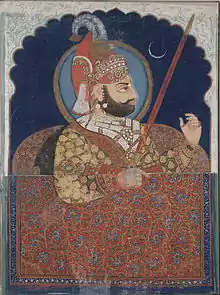| Bhim Singh of Mewar | |
|---|---|
| Ruler of Udaipur State | |
 Maharana Bhim Singh | |
| 1st Maharana of Udaipur | |
| Reign | 1818–1828 |
| Successor | Jawan Singh |
| 26th Maharana of Mewar | |
| Reign | 1778–1818 |
| Predecessor | Hamir Singh II |
| Born | 10 March 1768 |
| Died | 30 March 1828 (aged 60) |
| Spouse | Rathorji Akshay Kanwarji of Idar
Jhaliji Roop Kanwarji of Dhrangadhra in Gujarat Vagheliji Kushal Kanwarji of Gangad in Gujarat Chawdiji Gulab Kanwarji of Varsoda in Gujarat Devriji Sardar Kanwarji of Sirohi Rathorji Umaid Kanwarji of Idar Rathorji Padam Kanwarji of Bikaner Rathorji Chandra Kanwarji of Idar Jhaliji Braj Kanwarji of Lakhtar in Gujarat Jhaliji Saubhag Kanwarji of Tana in Mewar Bhatiyaniji Suraj Kanwarji from Jaisalmer Hadiji Kishor Kanwarji of Kota |
| Issue | Sons:-
Yuvraj Amar Singh Umaid Singh Prithvi Singh Daughters:- Krishna Kumari (died young) Ajab Kanwarji m.to Maharaja Ratan Singhji of Bikaner Roop Kanwarji m.to Maharawal Gaj Singhji of Jaisalmer |
| House | Ranawat Sisodia |
| Father | Ari Singh II |
| Mother | Jhaliji Sardar Kanwarji d.of Rana Kanha Singhji of Gogunda in Mewar |
| Religion | Hinduism |
| Sisodia Rajputs of Mewar II (1326–1971) |
|---|
|
Maharana Bhim Singh (10 March 1768 – 30 March 1828) was the 26th Maharana (r. 1778–1828) of the illustrious house of Sisodiyas of Mewar and the 1st Maharana of the Princely state of Udaipur. He was the second son of Maharana Ari Singh II and younger brother of Maharana Hamir Singh II.
At ten years of age Maharana Bhim Singh succeeded his brother, Hamir Singh II, who had died at 16 years of age from a wound when a rifle burst in his hand. Maharana Hamir Singh II had ruled an unstable state with an empty treasury under a regency by Maharaj Bagh Singh and Arjun Singh and his mother Jhaliji Sardar Kanwarji of Gogunda. Maharana Bhim Singhji inherited this unstable state, after its unpaid Maratha soldiers had looted Chittor. The soldiers' depredations continued and more territory was lost during Bhim Singh's rule.[1] Maharana Bhim Singhji's daughter Krishna Kumari, had died by drinking poison, at the age of 16, to save his dynasty and prevent a massive war among the rajput houses of Rajputana in 1810.[2]
Maharana Bhim Singh was unable to lead his house of Mewar as a political power in the entire Rajputana unlike his illustrious and effectual ancestors. Mewar had once been considered the strongest Rajput state because of its lengthy resistance to the foreign emperors, but by 13 January 1818, Maharana Bhim Singhji had to sign a treaty with the British East India Company, accepting their protection.[3][4][5]
On the birth of his heir Amar Singhji, Bhim Singh along with his nobles visited the Eklingji temple on foot and got an inscription engraved in the temple promulgating orders to abolish certain taxes from Charanas and Brahmins.[6]
On his death in the year 1828, his four wives and four concubines committed Sati in the traditional manner.[7]
References
- ↑ Bhawan Singh Rana, Maharana Pratap, Udaipur, Diamond Pocket Books (2004), pp. 139–140. ISBN 81-288-0825-7
- ↑ Joshi, Varsha (1995). Polygamy and Purdah: Women and Society Among Rajputs. Rawat Publications. ISBN 978-81-7033-275-6.
Krishna Kumari was the daughter of Maharana Bhim Singh of Mewar . She was betrothed to Maharaja Bhim Singh of Jodhpur but he died before the marriage could take place . Her father then wanted her to be married to Maharaja Jagat Singh of Jaipur : this was in 1806. Man Singh , who succeeded Bhim Singh at Jodhpur , expressed his desire to marry her . His argument was that Krishna Kumari was the mang of Jodhpur and therefore she should be betrothed to him . Daulat Rao Scindhia also opposed her marriage to the ruler of Jaipur. Man Singh collected about sixty thousand soldiers at Merta. He compelled the Maharana to call back his representatives going to Jaipur to perform the betrothal ceremony. Scindhia also attacked Udaipur and defeated the Mewar forces. On the other side Jagat Singh attacked Marwar. Krishna Kumari thus became the bone of contention between Jaipur, Jodhpur and Mewar. To avoid future calamities to Mewar and for the establishment of peace in Rajasthan, Krishna Kumari was given poison on 21 July 1810. She took this in order to save Mewar from further troubles .
- ↑ The Essential Guide, Art Institute of Chicago (2009), p. 14.
- ↑ Treaties, Engagements and Sanads of Indian States: A Contribution in Indian Jurisprudence, p. 59.
- ↑ The Law of the Indian Constitution: Being a Legal Interpretation of the Government of India Act, 1935 (26 Geo. V. C. 2) and a Study of the Structure of the Indian Constitution, Before and After the Federation, p. 66.
- ↑ Sources of Socio-economic History of Rajasthan and Malwa, 1700 C. to 1900 C. A.D. Maharaja Man Singh Pustak Bhandar. 1988.
- ↑ Gaur, Meena (1989). Sati and Social Reforms in India. Publication Scheme. p. 51. ISBN 978-81-85263-57-1.